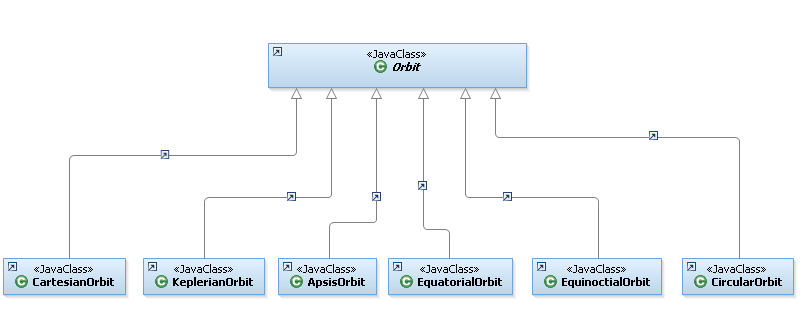User Manual 3.4.1 Orbits
Sommaire
Introduction
Scope
The "orbits" package contains classes to represent the orbital state of a spacecraft at a given time. Several types of orbits are available (cartesian, keplerian, equinoctial...). The jacobian matrix for each orbital parameter / cartesian parameter conversion are also available for their current value.
An "Orbit" (implementing "Orbit" class) object is not to be misunderstood with an "Orbital parameters" object (implement "IOrbitalParameters" interface). An orbit uses as attributes:
- Orbital parameters
- A date
- A frame (not necessarily inertial or pseudo-inertial)
For more information about orbital parameters, please refer to Orbital parameters.
Javadoc
The classes for orbits description are available in the package org.orekit.orbits of OREKIT.
| Library | Javadoc |
|---|---|
| Orekit | Package org.orekit.orbits |
Links
None as of now.
Useful Documents
None as of now.
Package Overview
All different orbits types extend the abstract generic Orbit class.
The enum "PositionAngle" lists the three types of position angle (anomaly, alpha angle...) available : TRUE, MEAN, ECCENTRIC.
Features Description
Available orbit types
The available orbit types are :
- Cartesian : X, Y, Z, Vx, Vy, Vz
- Keplerian : a, e, i, perigee argument, right ascension of ascending node, anomaly (in each position angle types)
- Equinoctial : a, ex, ey (eccentricity vector), hx, hy (inclination vector), true longitude argument (in each position angle types)
- Circular : a, ex, ey (eccentricity vector), i, right ascension of ascending node, true latitude argument (in each position angle types)
- Apsis : periapsis, apoapsis, i, perigee argument, right ascension of ascending node, anomaly (in each position angle types)
- Equatorial : a, e, longitude of the periapsis (ω + Ω), ix (first component of inclination vector), iy (second component of inclination vector), anomaly (in each position angle types)
Jacobians
For each orbital parameter type (keplerian, equinoctial, circular, apsis, equatorial), the jacobian matrices "orbital parameters with respect to cartesian parameters" and "cartesian parameters with respect to orbital parameters" are available. The jacobian matrix related to the conversion between an orbital parameter type A to an orbital parameter type B is also available (computed by getJacobian method) for each orbital parameter type.
For all except the equinoctial and equatorial parameters, the "with respect to cartesian parameters" jacobian (getJacobianWrtCartesian method) is computed with direct analytic methods, and the "with respect to orbital parameters" (getJacobianWrtParameters method) obtained by computing the inverse of the previous one.
For the equinoctial and equatorial parameters, both computations are direct and analytic.
Getting Started
Any orbit can be defined using the chosen constructor. Here is an to define a circular orbit:
final KeplerianParameters keplerianParameters = new KeplerianParameters(10000E3, 0.1, 0.2, 0.3, 0.4, 0.5, PositionAngle.TRUE, Constants.EGM96_EARTH_MU); final CircularOrbit orbit = new CircularOrbit(keplerianParameters, FramesFactory.getEME2000(), date);
Internal parameters of circular orbits are circular parameters. They can be retrieved and converted using conversion routines provided by [FDY_PARAM_Home Orbital parameters] objects:
final CartesianParameters cartesianParameters = orbit.getParameters().getCartesianParameters();
Contents
Classes
| Class | Summary | Javadoc |
|---|---|---|
| Orbit | Abstract class for all orbits. | ... |
| CartesianOrbit | Instant orbit described by its cartesian parameters. | ... |
| KeplerianOrbit | Instant orbit described by its keplerian parameters. | ... |
| CircularOrbit | Instant orbit described by its circular parameters. | ... |
| EquinoctialOrbit | Instant orbit described by its equinoctial parameters. | ... |
| EquatorialOrbit | Instant orbit described by its equatorial parameters. | ... |
| ApsisOrbit | Instant orbit described by its apsis parameters. | ... |
